10 Things To Look For When Buying The Freshest Potatoes
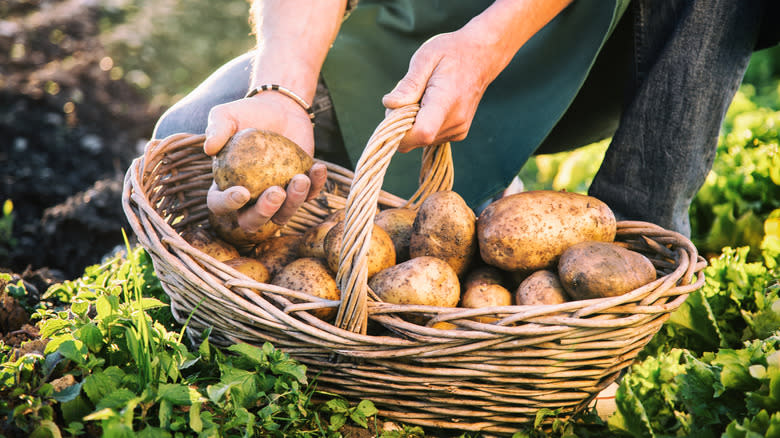
Potatoes have been growing in South America for thousands of years and are a staple food around the world. In fact, these humble tubers are the highest-selling vegetable in the country due, in part, to the many different kinds of potatoes to make affordable, tasty, and filling dishes. Potatoes are grown in almost every state in the country but are harvested just once a year, usually in September and October. They're kept in cold storage and sold year-round in grocery stores and markets, so it's important to understand how to select fresh potatoes before you purchase them.
We reached out to Kathy Sponheim, a passionate fourth-generation potato grower and co-owner of Michael Family Farms, a family potato business that opened in the 1950s and now grows 30 different types of potatoes in Urbana, Ohio. Whether we're roasting potatoes, mashing potatoes, or trying to make the ultimate French fry, potatoes play a big part in some of our favorite snacks and meals. Take note of these tips to bring home the best quality spuds for your favorite potato recipes.
Read more: 17 Types Of Potatoes And When To Use Them
Choose Firm, Unwrinkled Potatoes
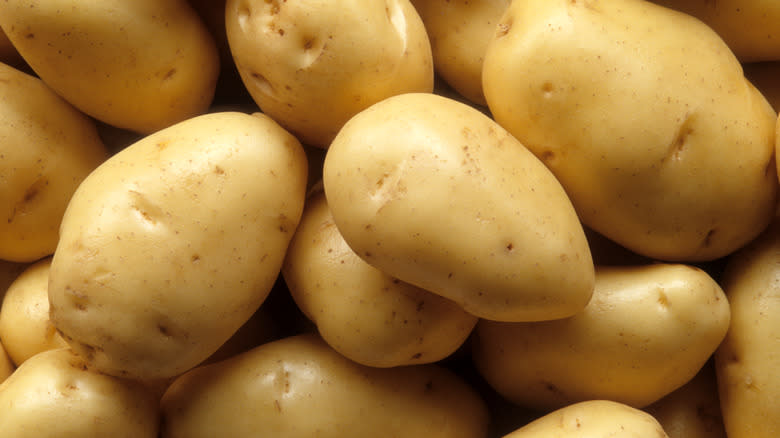
The first way to tell if those potatoes you're eyeing are fresh is to check how firm they are. There are a few reasons potatoes may soften that don't have to do with their freshness. If potato plants receive too much sunlight or are watered too much, they may become softer, and overly cold storage can have the same effect. But in general, Sponheim explains a firm consistency and smooth, unwrinkled skins point to freshness. She tells us: "When potatoes soften or have wrinkles that means they have started to lose water and are likely older potatoes -- or they haven't been stored in humidity-controlled areas."
We may not always think of our vegetables as alive, but potatoes are living organisms and have a life cycle just like every other plant. When the tubers are cut, they consume their own water supply to try to stay alive. As they age and sprout, potatoes use up additional moisture to support the new growth. So softness is a warning sign that those potatoes are over the hill. Potatoes that are just a little soft but look good otherwise can eaten, but if they are quite soft, mushy, or accompanied by an unpleasant odor, definitely pass them by.
Make Sure The Surface Is Free Of Cuts
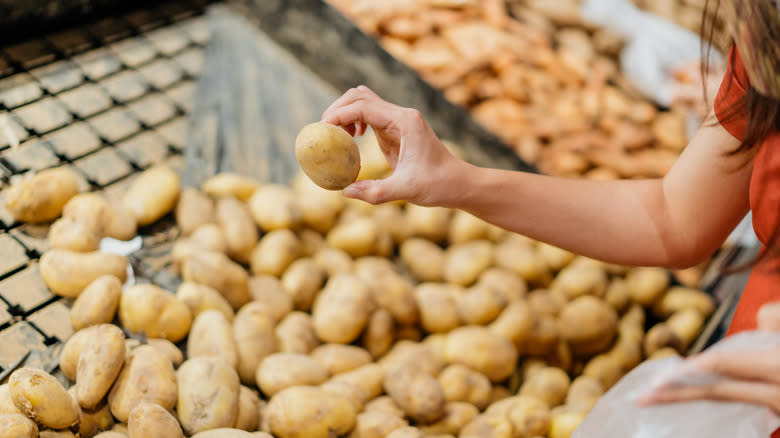
Ideally, try to choose potatoes with skin that is intact and free of cuts. Unblemished skin is a good sign on a potato, but we may not always find perfect specimens when shopping. Sponheim compares cuts on the vegetable's surface to cuts on human skin. "Cuts in potato skins often heal themselves very well and are often not noticed if not a deep cut," she explains. However, just like human cuts, they can sometimes indicate more serious issues like bacterial growth or mold.
Visually inspect any cut potatoes for mold, and toss the pieces with anything more than a very small area of mold, which can be safely cut off. Check for a bad odor as well, which is another indicator of mold growth. If you end up with potatoes that have deeper cuts and don't want to waste them, then after checking for mold Sponheim advises to "simply slice around the cut like you would a tomato or strawberry stem top."
Select Potatoes Without Discoloration
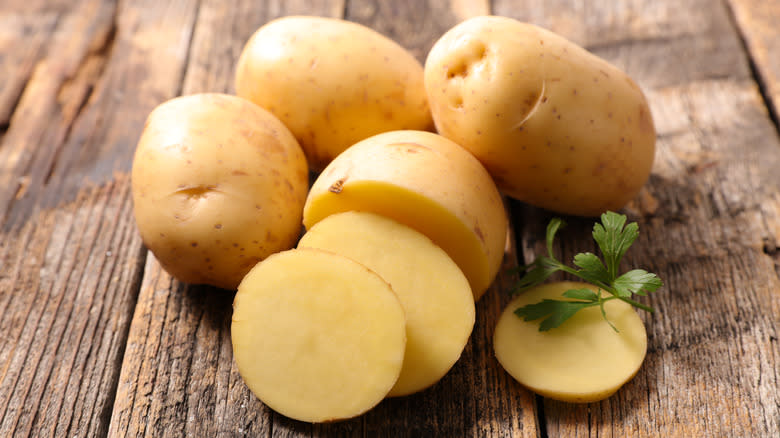
Potatoes look like one of the sturdier vegetables, but they have their sensitivities too. Believe it or not, they can be quick to bruise. Try to choose potatoes without any dark areas, and handle them carefully both at the store and at home.
Sponheim clarifies that "dark areas or discoloration at the skin level represent bruises. This happens sometimes at harvest during handling." She notes that pressure bruises, another kind of bruising, can occur later on in the storage season. But don't toss those taters just yet. She states that shallow bruises can be cut off and won't affect the safety of the rest of the potato.
Another kind of discoloration can sometimes be found in the interior flesh. "If there is discoloration in the middle of the potato, that is often internal brown spotting, which sometimes occurs during the growing season based off nutrient and water intake," Sponheim says. As long as it's not extensive then the tuber can be salvaged. Sponheim explains, "Most of the time it is able to be cut around for cooking."
Pass Over Sprouts
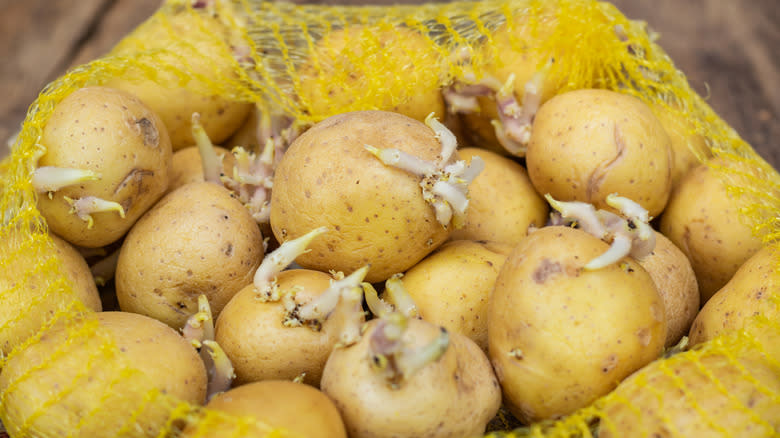
The life cycles of potatoes in stores aren't over just yet. If left long enough, they will grow shoots. "Sprouts are signs the potato is trying to grow into a potato plant and reproduce," says Sponheim. When shopping for potatoes, you shouldn't come across sprouts too often. Grocery stores have an inspection process and usually don't accept sprouting potatoes, Sponheim explains. They may sometimes accept pieces with very small sprouts that are shorter than a ¼ inch when it's clear that the grower has applied treatment to halt their growth. "But very, very rarely would you see sprouts in the store unless they've been in the store a long time," she emphasizes.
Given that sprouts indicate aged potatoes, avoid them in the store if possible. You're more likely to encounter spuds sending out shoots at home after you've forgotten about them for a while. Either way, always cut off sprouts because they are toxic.
There's no need to toss the whole potato unless large sprouts have really taken over. Sponheim advises: "If the sprout is little, it can be cut out and the rest of the potato is okay to eat." However, if the sprout is longer than ½ inch she recommends just cutting off a quarter or half of the potato with the sprout on it because the rest of the potato is still safe. "It's just you don't want to eat the sprout or the area directly around the sprout," she adds.
Be Careful With Green Potatoes
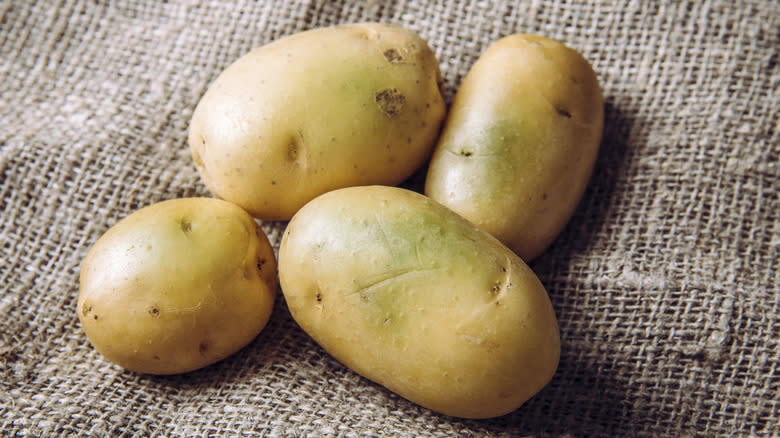
It's not uncommon to come across a green potato once in a while. Potatoes grow underground in the dark, and they undergo changes when brought out into the light. Greening is caused by a chemical called solanine, which builds up in the potato when it's exposed to light. "It's a shading process from light green to dark green," Sponheim tells us. "And the darker the green, the more of that is present."
Solanine not only changes the color of the potato, but it affects the flavor, too. "The greening causes a bitter taste and if eaten in large quantities can cause illness," Sponheim says. For that reason, be careful with green potatoes, but you don't need to waste them if the color change is mild. Sponheim advises: "If there is slight greening, just cut away the green portions before cooking." She explains that the color change is usually just skin deep, so peeling that skin off or cutting off that area of the potato will solve the problem. "You don't want to eat the green part," she says.
Choose Potatoes In Breathable Bags
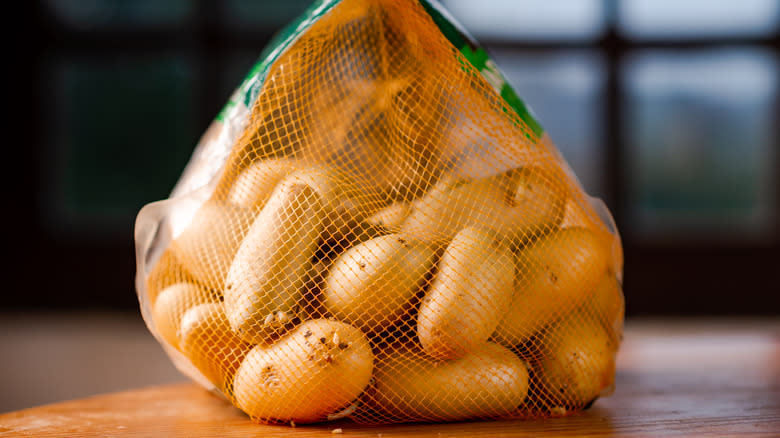
Make sure the potatoes you're considering buying are able to breathe. At the grocery store, look for those sold in perforated paper or plastic bags as opposed to solid bags, because they extend the shelf life of the product.
After harvest, Sponheim and other potato growers store their crops at 42 F until they're ready to ship to sellers. When the potatoes leave cold storage and are ready to go, they gradually return to room temperature and start to sweat. Sponheim points out that the evaporated moisture needs to escape from the bag or it will build up and cause bacterial or mold growth, and that's where the holes in the bag come in.
These bags are also called light blocker bags. Sponheim explains that the underside is perforated and they have a fully opaque, printed top made from a special material that prevents the light from reaching the potatoes. So the bags not only allow any moisture to evaporate out of the bag but prevent them from turning green from light exposure at the same time. "We have data on food waste reduction and several other things by using the light blocker bag," Sponheim tells us. "It costs a little bit more for us to package it that way, but it reduces food waste and it keeps the potatoes fresher longer."
Buy Local
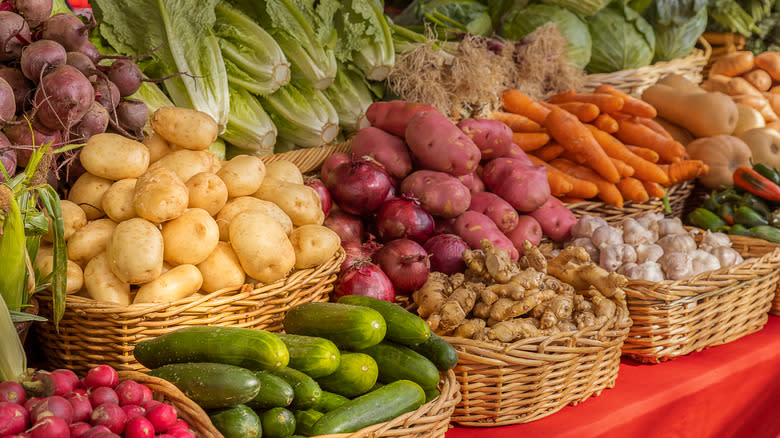
Try to buy locally to increase the likelihood of finding fresh, good-quality potatoes. "We encourage folks to buy local when they can," says Sponheim, explaining that locally grown foods are both good for the environment and provide people with fresher fruits and vegetables. Consider prioritizing local farmers' markets or local farm stands. If that's not possible, Sponheim suggests trying to find local products at the supermarket: "If your grocery store prioritizes local or supplies information about 'know your grower' that helps consumers know where their potatoes were grown." She explains that if the store can show that they support local farmers, you can know that your food hasn't racked up miles by traveling long distances.
When buying potatoes locally, consider the time of year. Sponheim reveals that potatoes are harvested between August and mid-October in the general area of the country north of Kentucky. Potatoes sold at farmers' markets during this time are probably freshly harvested because small farms likely don't have long-term potato storage facilities like commercial operations do.
You needn't skip potatoes from commercial farms, though. Once harvest ends, growers like Sponheim store their potato crop in coolers with controlled ventilation, humidity, and temperature that cause the potatoes to hibernate. They are stored dirty and not washed until shipping day so they don't deteriorate and are available until the following summer.
Look For The Freshest Variety
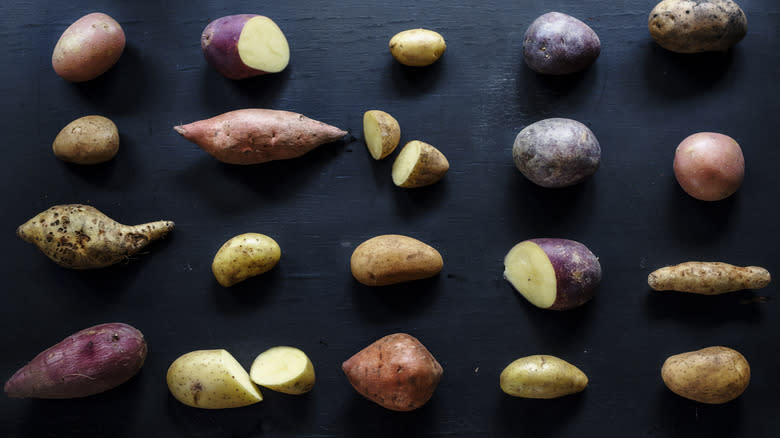
What happens if the potatoes you're looking at look less than inviting? In this case, Sponheim's advice is to consider choosing different types of potatoes other than what you originally planned to buy. Keep an open mind if one choice doesn't check the boxes for signs of freshness. "Don't be afraid to try a different type of potato if say, what you normally buy is out of stock or if it looks older or lower quality," Sponheim says.
She continues that if someone normally buys Russet potatoes but either they're low on stock or not the freshest looking, look to try a yellow, round white, or red potato because, based on seasonality, it could be a lot fresher. The upside of this experimentation is that you may just discover new tastes and dishes you otherwise wouldn't have tried. "Different types of potatoes are used for different recipes," says Sponheim. "The best potato for a baked potato would be a Russet. The best potato for mashed would be a round white potato."
If you're looking to make soups or potato salads, she recommends buying a red potato because it will hold its shape. "If you're looking for a buttery smooth mashed or grilled potato, it could be a yellow," she says. While certain varieties of potatoes have ideal uses, she emphasizes that potatoes can be used interchangeably and trying a new kind can lead you to an exciting new dish or way of eating.
Don't Forget About Sweet Potatoes
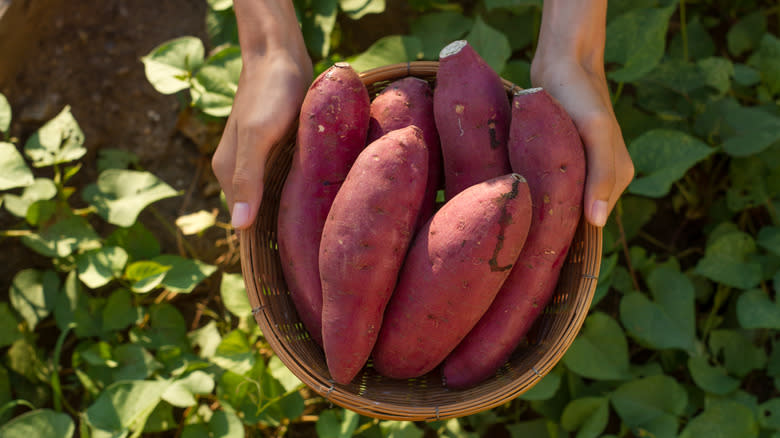
You may be wondering if these tips apply to sweet potatoes. Sponheim clarifies that while potatoes are tubers, sweet potatoes are roots, so they don't always react the same way. For example, they don't turn green or sprout.
In terms of checking for freshness, she points out that there are similarities between the two. First, choose firm pieces without wrinkles because that means they're not dehydrated. Sweet potatoes can get bruises and cuts just like white potatoes, so she advises making sure these are not present because cuts can make them susceptible to mold.
Since they are a root, sweet potatoes are also more susceptible to mold in the area where they're cut off, so make sure they don't have any cuts or wetness in that area. As with any potato, pass over them if they show signs of rotting, which include a mushy consistency, bad odor, or dark black or brown spots.
Keep Potatoes Fresh With Proper Storage
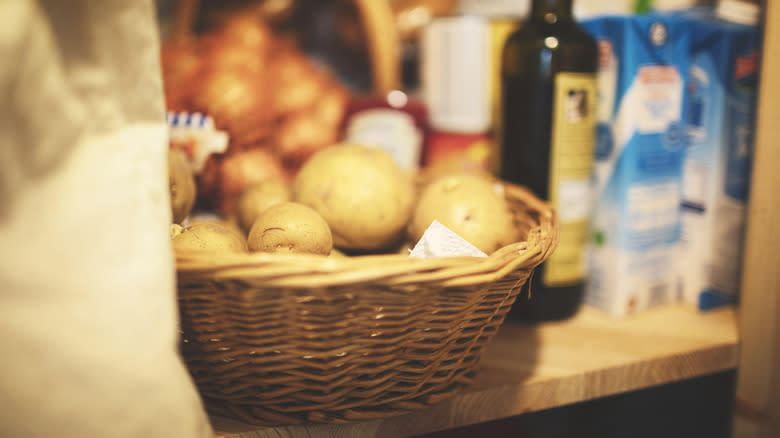
After you've gone to the trouble of selecting the freshest potatoes, make sure you store them properly once you bring them home so they'll stay in great shape until you're ready to cook them. Many of us have had the disappointing experience of finding our potatoes looking sad and wrinkly or, even worse, growing curiously long green shoots like in an elementary school science experiment.
"Store potatoes in a cool, well-ventilated, dark place," Sponheim tells us. Storing your potatoes out of the light will keep them from sprouting for as long as possible. Make sure they're in a position to breathe, so don't bury them in a big pile. You can keep them in the perforated bags they came in or spread them out in a shallow layer to encourage airflow.
"Do not store [potatoes] in the refrigerator as colder temperatures cause the potato's starch to convert to sugar," Sponheim says. This transformation will make them taste slightly off. On the other hand, store them in a warm place and they will get shrunken and wrinkly. Make sure the area is dry too. "Don't wash potatoes before storing," Sponheim says. "Dampness promotes early spoilage." The last thing we want is moldy spuds. She finishes by saying that potatoes will keep well for a week or two if properly stored in a cool, dark area.
Read the original article on Tasting Table.

